It's taking me a while to go through my photos from Belize. That's partly because I like to try to identify what I photograph underwater. And that's not easy!
We've gotten to like the small stuff when we're diving - nudibranchs, christmas tree worms, crabs, shrimp, etc. I remember when I first started diving and the dive master would point out some tiny creature. I'd be struggling to control my buoyancy, mask leaking and fogged up, and I'm afraid I wasn't very interested. But with experience, the diving part is more automatic, and now I love seeing and finding these little critters. Rafael Murillo at Dolphin Dive in Loreto, Baja Mexico also deserves thanks for, over the years, showing us how rewarding it can be.
When non-divers hear you've been diving, they usually ask one of two questions: Did you see any sharks? How deep did you go? Neither is really my thing. I'd rather see a sea slug in shallow water. Sharks are ok, but really, they're just big fish.
For some reason, there aren't as many nudibranchs where we were diving in Belize. But Cardinal, our dive master for most of the time at Blackbird Caye, managed to find a few for us. We saw a couple of these Lettuce sea slugs:

The next was a Red-tipped sea goddess nudibranch. (head to the left, gills protruding at the other end)
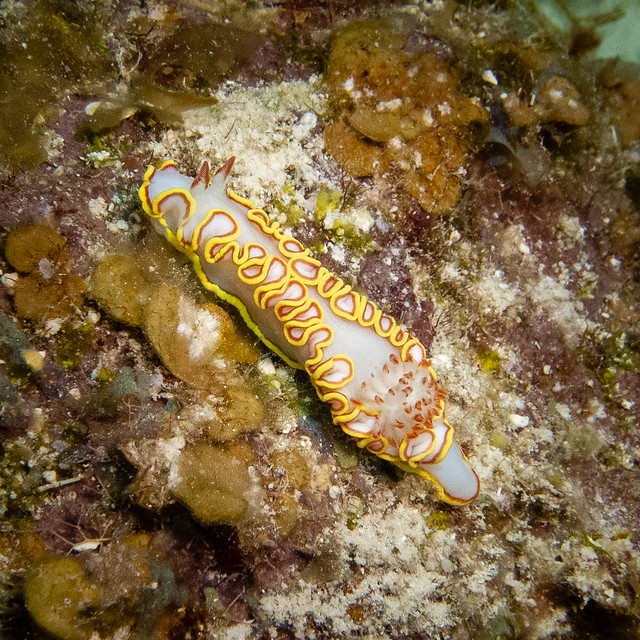
And the last was this Black spotted nudibranch. (Although I'm not sure why it's a nudibranch since that means "naked lung" and this one doesn't appear to have that.)
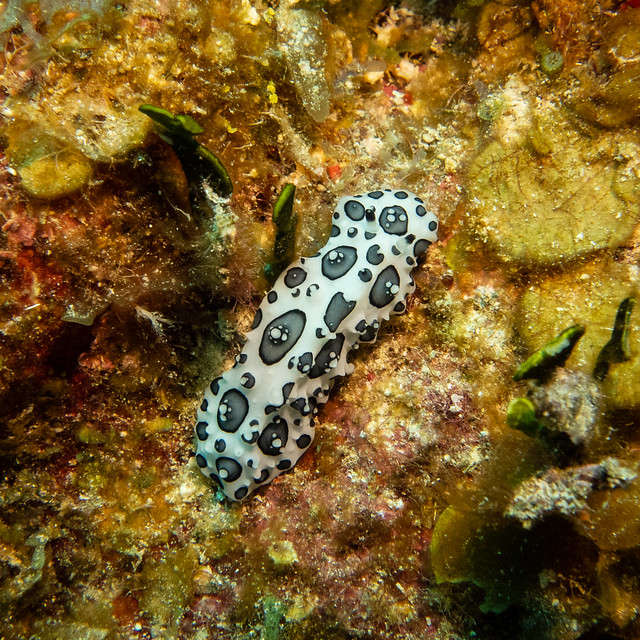
You can think of slugs as snails without shells. One with a shell that I like to see are the Flamingo Tongues (does a flamingo's tongue really look like that?). The shells are actually plain white, the spotted pattern is their mantle (foot) that they wrap over the shell. (The things nature comes up with!) Here's one on a sea fan:

We came across these two with their mantles retracted, which apparently happens if they are attacked, although there was no sign of that. Maybe they're fighting (or mating?) in slow motion.

There weren't as many Christmas tree worms as some places, but they were still quite a few. You have to approach them carefully or they withdraw their "trees" and you're left with nothing to photograph. Each pair of trees is one worm. The trees are a combination of feeding filter and gill. The worms have a kind of tube shell but often it's hidden since they will build it inside a hole they bore in the coral.

The Star horseshoe worm is similar but without the spiral.
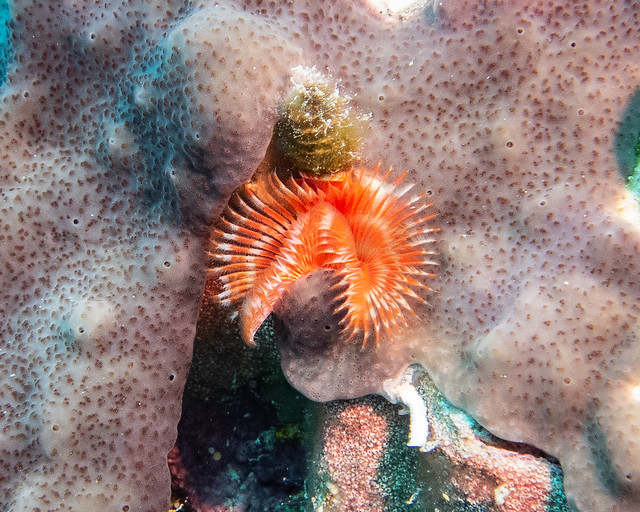
Feather duster worms are larger, and often not as brightly colored. These ones live in the sand rather than on the coral. It's hard to see unless you zoom in on the photo, but there are dozens of smaller fan worms in this photo.
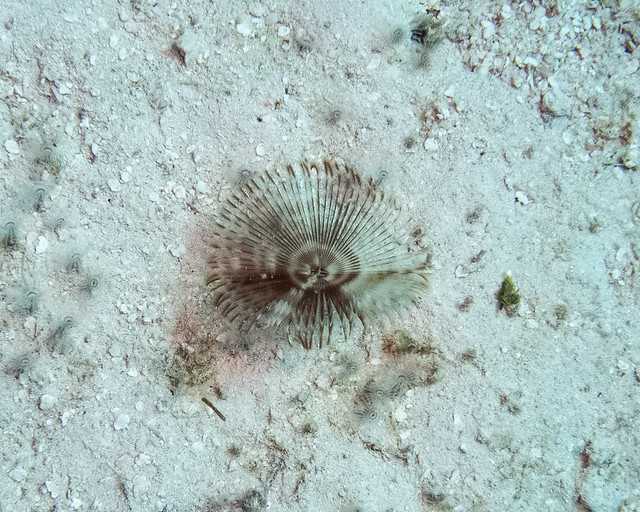
We saw quite a few Sponge brittle stars once we learned how to look for them. Some of the big barrel sponges were covered with them if you looked closely. Other vase sponges like this one would have a single one in them. They were hard to get a good photo of because there would often only be a couple of legs sticking out with the rest of them hidden.

The yellow plant like thing is a Golden crinoid aka sea lily. It's actually an animal, related to sea stars, but with many more than five arms. Sometimes it's fixed in place like a plant, other times it's mobile.
I can never resist looking inside the barrel and tube sponges. Usually there's nothing inside them, but occasionally you'll find something like a brittle star or crab or shrimp. There were actually quite a few of these Coral banded shrimp around. The trick was to look for their white antennas.

The Pederson cleaning shrimp were also relatively common, but they're quite small and despite their purple color, they are translucent and hard to spot.

Here's a Yellowline arrow crab in a Corkscrew anemone, with an entourage of Pederson cleaning shrimp:
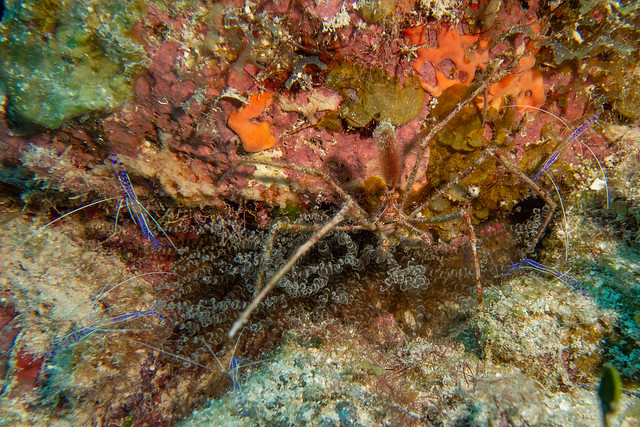
The arrow crab has amazing large red striped eyes. And a bizarre large "horn". I'm not sure if the fuzziness of the horn is part of the crab, or is algae growing on it.

I still often struggle to see what the dive master is trying to point out. It took me a while to realize this lump was alive, and rhythmically pumping water in and out of its siphon (the orange hole) to feed. It's a sea squirt, a kind of tunicate.

I'd seen these sea pearl alga in a photograph and thought they looked cool, so I was glad to find one. It looked just like a shiny marble.

I'll do another post with fish, but on the topic of small stuff, I like the little Neon gobies (around an inch long), maybe partly because they perch on the coral and therefore are easier to photograph (except they're also skittish). Usually there'd be just one or two on a coral, but for some reason there were dozens on this brain coral.
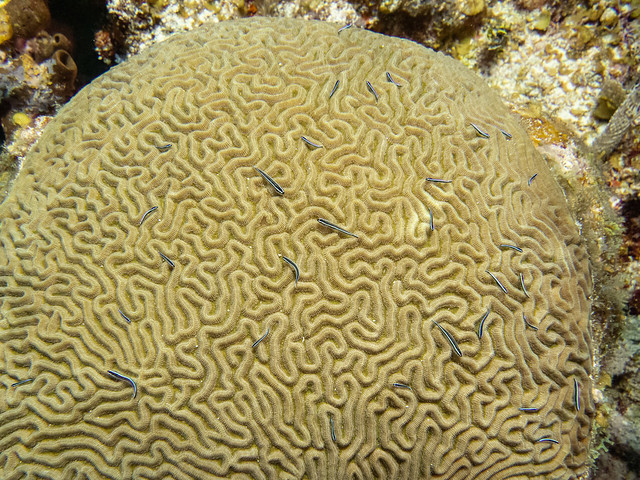

See all 34 photos in this album
See also a previous post about Slugs and Worms from Baja
We've gotten to like the small stuff when we're diving - nudibranchs, christmas tree worms, crabs, shrimp, etc. I remember when I first started diving and the dive master would point out some tiny creature. I'd be struggling to control my buoyancy, mask leaking and fogged up, and I'm afraid I wasn't very interested. But with experience, the diving part is more automatic, and now I love seeing and finding these little critters. Rafael Murillo at Dolphin Dive in Loreto, Baja Mexico also deserves thanks for, over the years, showing us how rewarding it can be.
When non-divers hear you've been diving, they usually ask one of two questions: Did you see any sharks? How deep did you go? Neither is really my thing. I'd rather see a sea slug in shallow water. Sharks are ok, but really, they're just big fish.
For some reason, there aren't as many nudibranchs where we were diving in Belize. But Cardinal, our dive master for most of the time at Blackbird Caye, managed to find a few for us. We saw a couple of these Lettuce sea slugs:

The next was a Red-tipped sea goddess nudibranch. (head to the left, gills protruding at the other end)

And the last was this Black spotted nudibranch. (Although I'm not sure why it's a nudibranch since that means "naked lung" and this one doesn't appear to have that.)

You can think of slugs as snails without shells. One with a shell that I like to see are the Flamingo Tongues (does a flamingo's tongue really look like that?). The shells are actually plain white, the spotted pattern is their mantle (foot) that they wrap over the shell. (The things nature comes up with!) Here's one on a sea fan:

We came across these two with their mantles retracted, which apparently happens if they are attacked, although there was no sign of that. Maybe they're fighting (or mating?) in slow motion.

There weren't as many Christmas tree worms as some places, but they were still quite a few. You have to approach them carefully or they withdraw their "trees" and you're left with nothing to photograph. Each pair of trees is one worm. The trees are a combination of feeding filter and gill. The worms have a kind of tube shell but often it's hidden since they will build it inside a hole they bore in the coral.

The Star horseshoe worm is similar but without the spiral.

Feather duster worms are larger, and often not as brightly colored. These ones live in the sand rather than on the coral. It's hard to see unless you zoom in on the photo, but there are dozens of smaller fan worms in this photo.

We saw quite a few Sponge brittle stars once we learned how to look for them. Some of the big barrel sponges were covered with them if you looked closely. Other vase sponges like this one would have a single one in them. They were hard to get a good photo of because there would often only be a couple of legs sticking out with the rest of them hidden.

The yellow plant like thing is a Golden crinoid aka sea lily. It's actually an animal, related to sea stars, but with many more than five arms. Sometimes it's fixed in place like a plant, other times it's mobile.
I can never resist looking inside the barrel and tube sponges. Usually there's nothing inside them, but occasionally you'll find something like a brittle star or crab or shrimp. There were actually quite a few of these Coral banded shrimp around. The trick was to look for their white antennas.

The Pederson cleaning shrimp were also relatively common, but they're quite small and despite their purple color, they are translucent and hard to spot.

Here's a Yellowline arrow crab in a Corkscrew anemone, with an entourage of Pederson cleaning shrimp:

The arrow crab has amazing large red striped eyes. And a bizarre large "horn". I'm not sure if the fuzziness of the horn is part of the crab, or is algae growing on it.

I still often struggle to see what the dive master is trying to point out. It took me a while to realize this lump was alive, and rhythmically pumping water in and out of its siphon (the orange hole) to feed. It's a sea squirt, a kind of tunicate.

I'd seen these sea pearl alga in a photograph and thought they looked cool, so I was glad to find one. It looked just like a shiny marble.

I'll do another post with fish, but on the topic of small stuff, I like the little Neon gobies (around an inch long), maybe partly because they perch on the coral and therefore are easier to photograph (except they're also skittish). Usually there'd be just one or two on a coral, but for some reason there were dozens on this brain coral.


See all 34 photos in this album
See also a previous post about Slugs and Worms from Baja
No comments:
Post a Comment